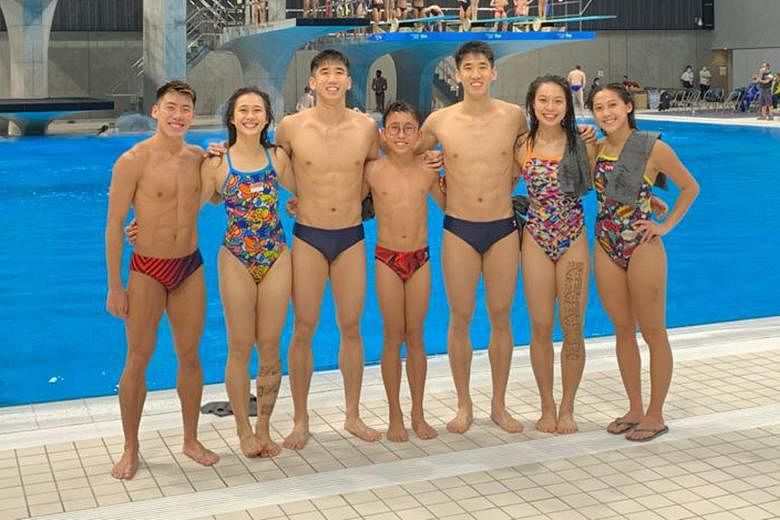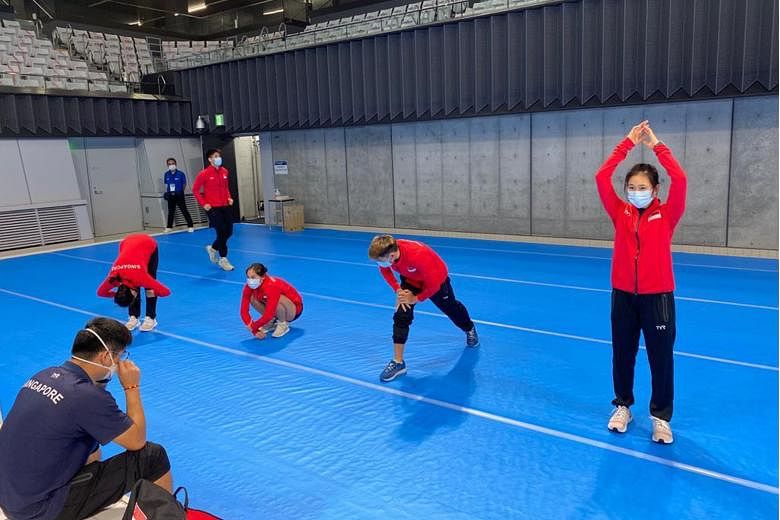Allocated training sessions, limited movement outside of their hotel rooms and absolutely no food deliveries.
Seven divers are the first Singapore athletes to get a taste of the strict guidelines that will be in play for the July 23-Aug 8 Tokyo Olympics.
They departed for the Japanese capital on Monday night for the May 1-6 Fina Diving World Cup, in what will be their last shot at securing a place at the Olympics.
The seven are Jonathan Chan, Mark Lee, Timothy Lee, Max Lee, Freida Lim, Fong Kay Yian and Ashlee Tan. Only Chan has qualified for the Games.
The biennial World Cup, originally slated for April last year, was postponed by a year owing to the coronavirus pandemic. It was only on April 10 that Fina announced that the competition would be rescheduled. The Cup will feature the best divers from around the world in the 3m springboard and 10m platform in both individual and synchronised events.
But with Tokyo entering a third state of emergency on April 25, those involved in the competition have to undergo strict protocols, which include a minimum of five antigen tests and moving only within their own bubble from the hotel to the competition venue.
Before departing for Tokyo, the divers had to take a polymerase chain reaction (PCR) test and they were seated separately from other passengers - clothed in full personal protective equipment (PPE) suits as an added precaution - on the flight there.
As the flight was not full, they also had a dedicated toilet on the plane.
Upon arrival at Narita International Airport, they took another saliva antigen test, and had to wait for their results to come back negative before they were allowed to leave the airport. The whole process took about two hours.
NO ROOM SERVICE OR DELIVERIES
The Singaporeans are housed on the same floor at Tokyo Bay Shiomi Prince Hotel, the designated hotel for the competition. In order to minimise contact with others, they can leave their rooms only at designated times to collect their meals from a small station located on the same floor. They are not allowed to order any food delivery or room service.
Travel to training sessions or for their respective events at the Tokyo Aquatics Centre is in a designated vehicle.
The tournament venue is split into three zones: an area to warm up, a dry-land training room as well as the dive pool. At training sessions, countries are split into different groups and athletes are allowed to train only within their respective groups. Each group is made up of eight countries in total, with at least 40 divers.
For dry-land training that takes place in a specific room, the training group is further split to consist of only four countries and 20 divers.
The divers are allocated two training sessions a day - one in the morning and one in the afternoon - with each session lasting for two hours, about half of what they are used to.
They are allowed to spend only half an hour warming up poolside, half an hour in the dry-land training area and one hour in the pool.
With 40 divers in a training group, this also signifies longer waiting times for their turn on the diving board, which according to Tan, is not ideal because it "compromises" their training time.
INCONVENIENT BUT NECESSARY
Mask-wearing is optional, but the Singapore team will be keeping their masks on during warm-up and dry-land training as an added precaution. The masks will come off only when they are going into water. Coaches and officials on the other hand, are expected to wear masks and face shields throughout.
Fong, who is taking part in the women's 3m springboard, admitted that the additional precautionary measures have been somewhat inconvenient for the team.
She said: "There isn't the freedom to go out and get whatever we need, like food for example, which is a bit frustrating. We have to keep requesting and they (the organisers) are not always able to provide. But we understand where they are coming from."
Despite the many restrictions, the divers remain in high spirits, as this is their first major international competition in over 15 months - with their last being the 2019 SEA Games in the Philippines.
Tan, who is also taking part in the women's 3m springboard, added: "(The protocols are) strict but necessary. It makes me feel safe knowing that we are taken care of."


